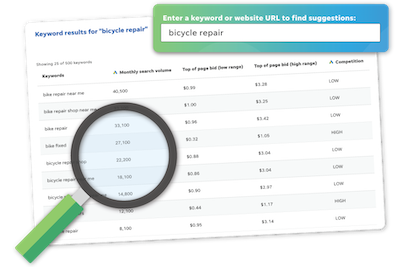Popular Keyword – Insurance Business Keywords
Search Popular Keywords in Your Industry
These are the most popular suggestions for Insurance Business Keywords generated by WordStream’s Free Keyword Tool. To get have all of these keywords sent to you, simply enter your Email address and click “Email Keywords” below.
Your keywords are on the way to your inbox!
Insurance Business Marketing Tips and Tricks
Let’s start with a simple fact: human beings are risk averse creatures. When we’re faced with uncertainty, we take measures to hedge against the risk of something going wrong.
For example, if a young man wants to go for a run outside and there’s a good chance of rain, he can run with a jacket tied around his waist. Sure, he’ll most definitely take some heat from his insecure peers who inexplicably mock those who think practically. But, he will have successfully insured himself against the impending rain. The same line of thinking drives the various insurance markets—home, auto, life, you name it.
The purpose of this example is to remind insurance marketers of what their prospects are looking for: protection against risks in an unpredictable world. Selling insurance is selling security.
Selling insurance is also expensive. The average Google Ads (formerly known as Google AdWords) cost per click (CPC) for insurance-related keywords is a mind-numbing $55. As defeating as that may feel at first, it makes total sense—insurance is an incredibly competitive industry, and securing a single customer is a pretty big deal.
So, how can insurance marketers generate leads for their sales teams without burning through their budgets on a couple clicks? Let’s talk tactics.
It’s best to begin generally. Google uses lower CPCs to reward advertisers who offer relevant experiences to their prospects. We won’t get into the nitty-gritty of the Google Ads auction here, but the basic gist is this: the higher your Quality Score, the better your ad position and the lower your CPC. You can boost your Quality Score by driving higher click-through rates (CTRs) and optimizing your landing pages. Think of this system as a positive feedback loop: higher CTRs, better Quality Score, better ad position, higher CTRs, and so on.
A great way to increase your CTRs is to put your special offers in your headlines rather than in your descriptions. Don’t flatter yourself—no matter how terrific your ad copy is, prospects are basically just skimming the sponsored headlines. Don’t miss your only chance to get their attention! Something like “Get Your Free Quote Today!” or “Access to 24/7 Customer Support” has a better chance of standing out amongst the rest.
Don’t get it twisted—consumers’ tendency to skim doesn’t mean you should blow off your ad copy. In 2017, WordStream found that half of the most successful paid search ads incorporate positive sentiment into their copy. Insurance marketers should consider filling their copy with phrases like “live a longer, happier life” rather than “protect your family from danger.” As always, we encourage some good old fashioned A/B testing.
Up until this point, we’ve discussed tactics to help you drive higher CTRs and, thus, minimize your CPCs. But, the unfortunate reality of insurance marketing is that clicks are going to expensive no matter what. The good news: remarketing lists for search advertisements (RLSA) is a thing. This tool allows you to adjust your bids on a particular keyword when one of your remarketing prospects searches something related to that keyword.
Let’s say a prospect clicks on one of your search ads and eventually leaves your site without converting. Traditional Google Display Network (GDN) remarketing allows you to keep your brand on her mind, but doesn’t necessarily reach her when she’s interested in buying insurance. This leads to wasted impressions. Alternatively, with RLSA, you can ramp up your efforts (with a higher bid) specifically when the prospect demonstrates commercial intent—when she’s most likely to click and convert.
To wrap it up nicely: offer a highly relevant ad experience to prospects with commercial intent and you’ll do just fine in paid search.
For more online advertising wisdom, check out the WordStream blog.
BUSINESS KEYWORDS
- Accounting Keywords
- Affiliate Keywords
- Auto Insurance Keywords
- B2B Ecommerce Keywords
- B2B Keywords
- Biotechnology Keywords
- Business Keywords
- Business Management Keywords
- Business Travel Keywords
- Construction Keywords
- Credit Card Keywords
- Debt Keywords
- Entertainment Keywords
- Finance Keywords
- Human Resources Keywords
- Insurance Business Keywords
- Internet Security Keywords
- Management Keywords
- Office Supplies Keywords
- Online Payment Solutions Keywords
- Software Keywords
- Startup Keywords
- Web Hosting Keywords
CONSUMER KEYWORDS
- Art Keywords
- Automotive Keywords
- Casino Keywords
- Cell Phone Keywords
- Computer Keywords
- Dating Keywords
- Ecommerce Keywords
- Electronics Keywords
- Email Keywords
- Fashion Keywords
- Golf Keywords
- Hotel Keywords
- Internet Keywords
- Jobs Keywords
- Law Keywords
- Mortgage Keywords
- Music Keywords
- Online Stores Keywords
- Pest Control Keywords
- Photography Keywords
- Plumbing Keywords
- Real Estate Keywords
- Restaurants Keywords
- Shoes Keywords
- Travel Keywords
- Wedding Keywords
FINANCE KEYWORDS
HEALTH & WELLNESS KEYWORDS
MISCELLANEOUS KEYWORDS
- Aerospace Keywords
- Agriculture Keywords
- Best Travel Keywords
- Coffee Keywords
- Dog Training Keywords
- Education Keywords
- Environmental Keywords
- Food & Beverage Keywords
- Forex Keywords
- Gifts Keywords
- Home Based Business Keywords
- Home Improvements Keywords
- Internet Games Keywords
- iPhone Keywords
- Jewelry Keywords
- Landscaping Keywords
- Legal Keywords
- Luggage Keywords
- Pharmaceutical Keywords
- Poker Keywords
- Retail Keywords
- School Education Keywords
- Solar Energy Keywords
- Transporation Keywords
- Women Fashion Keywords
- Work From Home Keywords

